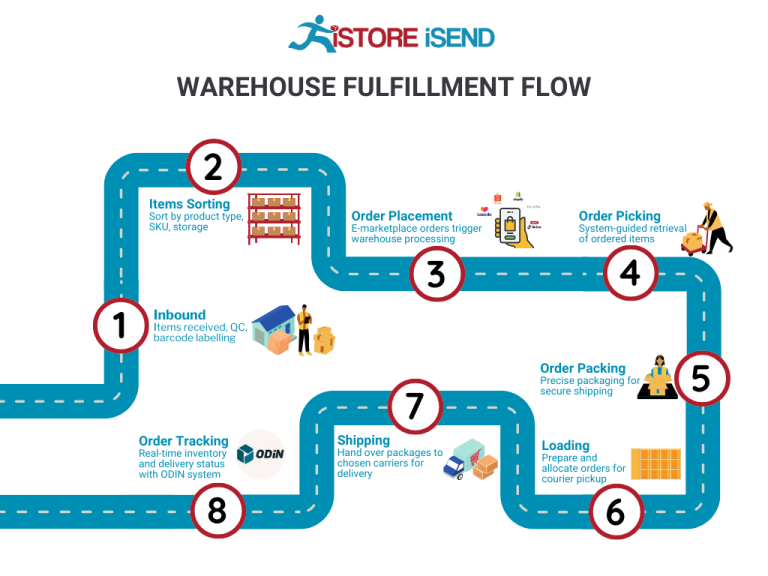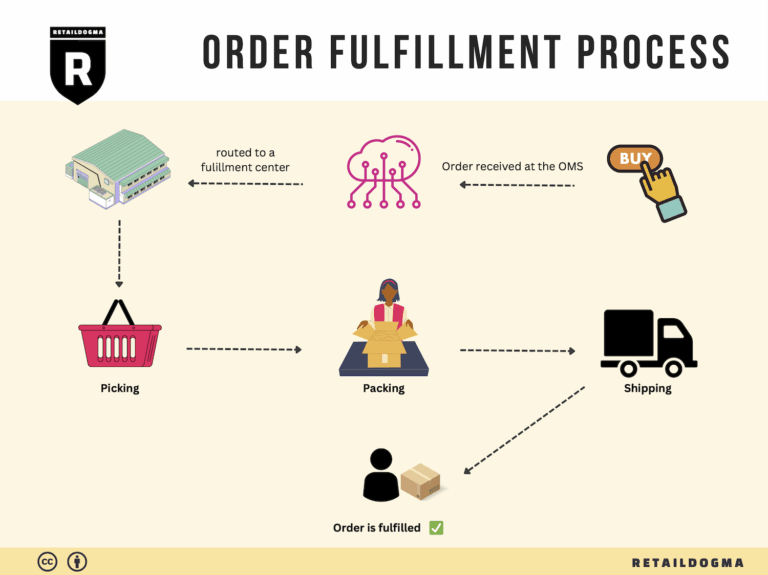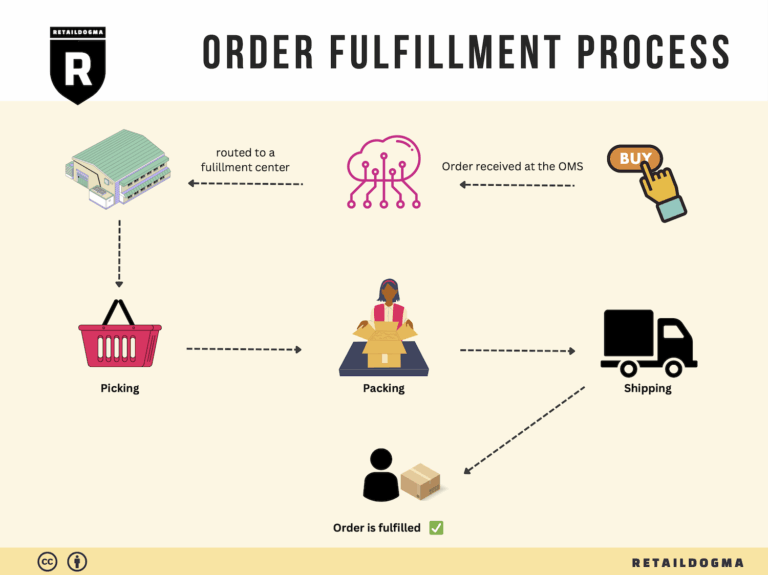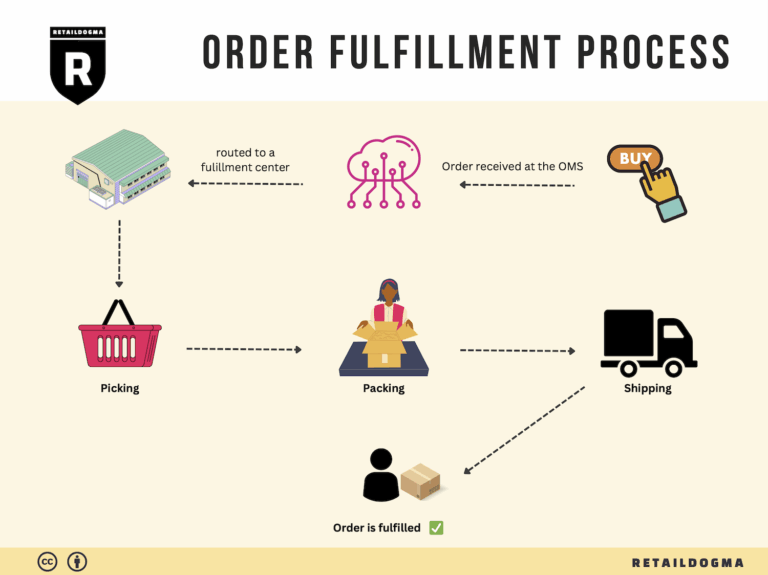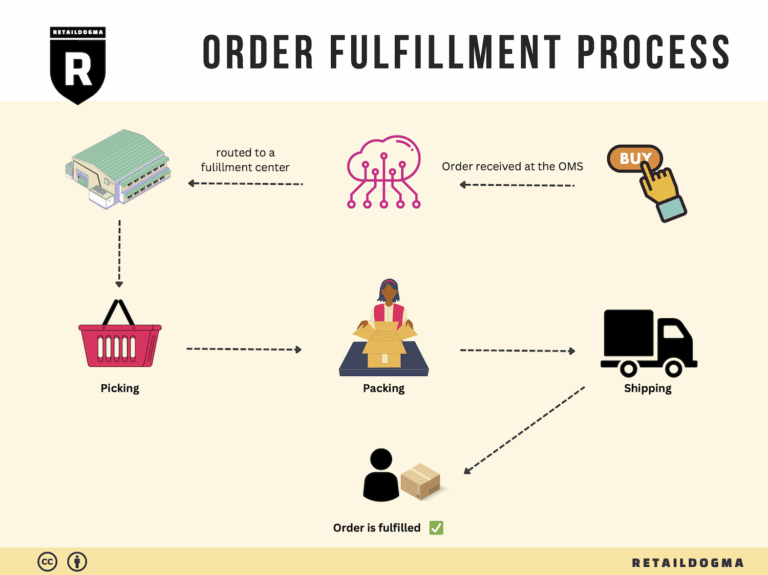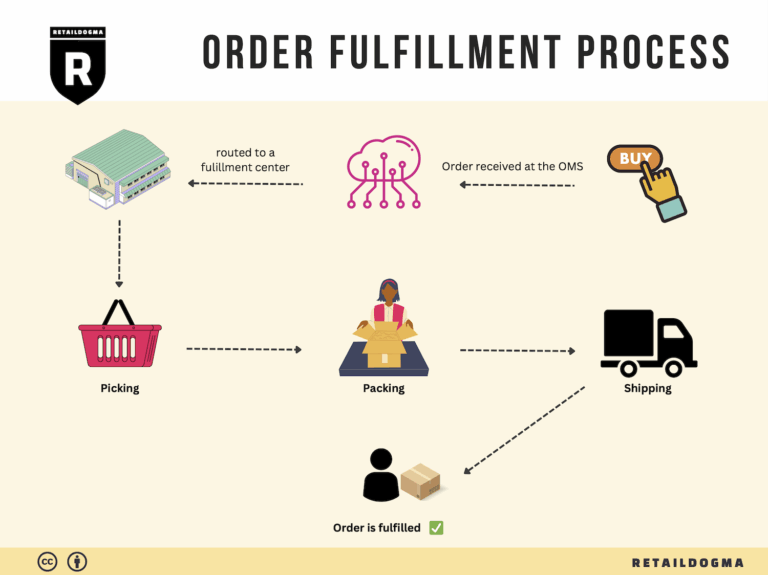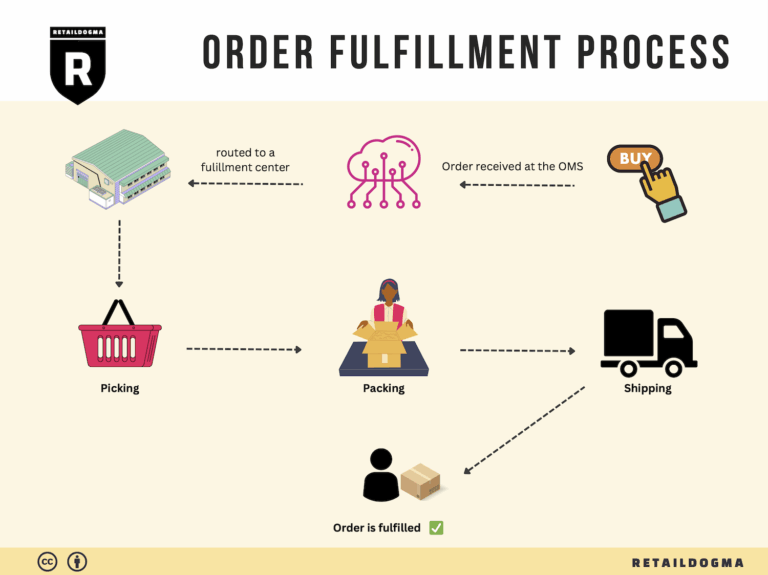How Order Fulfillment Works: A Step-by-Step Guide for Businesses
What is E-commerce Fulfillment? An Introduction for Growing Businesses
Understanding the Challenges of E-commerce Fulfillment
For many growing e-commerce businesses, one of the most daunting challenges is managing the logistics of packing and shipping orders. As sales increase, the once manageable task of fulfilling orders can quickly become overwhelming. Business owners find themselves juggling inventory management, picking and packing products, and navigating shipping logistics, all while trying to maintain a high level of customer satisfaction. This is where e-commerce fulfillment comes into play.
E-commerce fulfillment refers to the entire process of getting a product into the hands of a customer. It encompasses everything from receiving inventory and managing stock levels to packing orders and arranging for their shipment. As your business scales, having a streamlined fulfillment process becomes crucial not only for efficiency but also for maintaining your brand’s reputation.
What This Guide Covers
In this guide, we will explore the various fulfillment models available to e-commerce businesses, including Third-Party Logistics (3PL) and Fulfillment by Amazon (FBA). Each model has its own advantages and challenges, and understanding these can help you make informed decisions about which approach aligns best with your business goals.
We will delve into the core services that fulfillment partners typically offer, such as inventory management, order processing, shipping solutions, and returns handling. Selecting the right fulfillment partner is critical; thus, we will provide insights on what to look for, including experience, technology capabilities, and customer service.
Additionally, pricing can be a complex aspect of fulfillment, and this guide will outline the various factors that can influence costs, helping you to budget effectively as you scale your operations.
Empowering Your Business Decisions
Ultimately, the goal of this guide is to empower e-commerce business owners, operations managers, and entrepreneurs to make smart, informed decisions about their logistics strategies. By understanding the fundamentals of e-commerce fulfillment and the available options, you can enhance your operational efficiency, improve customer satisfaction, and drive your business growth.
What You’ll Learn In This Guide
- What is E-commerce Fulfillment? An Introduction for Growing Businesses
- The Order Fulfillment Process: From ‘Buy’ Button to Customer’s Door
- Comparing Fulfillment Models: In-House vs. 3PL vs. Dropshipping
- A Deep Dive into Amazon FBA: Pros, Cons, and Who It’s For
- Core Services Offered by Fulfillment Centers
- How to Choose a Fulfillment Partner: A 6-Point Checklist
- Understanding Fulfillment Pricing: A Breakdown of Common Fees
- Frequently Asked Questions (FAQs) about Fulfillment
- Conclusion: Is Outsourcing Fulfillment the Right Move for Your Business?
- Important Disclaimer
The Order Fulfillment Process: From ‘Buy’ Button to Customer’s Door
1. Receiving Inventory
The order fulfillment process begins with receiving inventory at the fulfillment center. This step involves the physical arrival of products from suppliers or manufacturers, which are then checked for accuracy against purchase orders. Each item is logged into the inventory management system, often using Stock Keeping Units (SKUs) to ensure that every product is accounted for.
Importance: Efficient receiving is crucial as it sets the stage for all subsequent steps. Properly received and documented inventory minimizes errors and ensures that products are readily available for picking. A smooth receiving process also helps to maintain the overall efficiency of the supply chain, reducing the risk of stockouts or overstock situations.
2. Warehouse Storage
Once the inventory has been received and logged, the next step is warehouse storage. Products are organized and stored in designated locations within the fulfillment center, using a systematic layout that optimizes space and accessibility. This may involve using various storage methods, such as shelving, bins, or pallets, depending on the type of product.
Importance: Effective storage strategies are essential for streamlining the picking process. By organizing products logically and efficiently, businesses can reduce the time and labor needed to retrieve items for orders. Additionally, a well-maintained storage system supports accurate inventory tracking, which is vital for managing stock levels and forecasting future needs.
3. Order Picking
With products stored and organized, the next step is order picking. This process involves retrieving items from their storage locations based on incoming customer orders. Fulfillment centers typically utilize pick lists—documents that outline the items to be picked for each order, along with their corresponding locations.
Importance: Order picking is a critical step in the fulfillment process as it directly impacts order accuracy and customer satisfaction. Efficient picking methods, such as batch picking or zone picking, can significantly reduce the time taken to fulfill orders. Moreover, ensuring that the right items are picked helps prevent costly returns and enhances the overall customer experience.
4. Order Packing
After the items are picked, they move to the packing stage. Here, products are carefully packaged for shipment, ensuring that they are protected during transit. This step may involve choosing appropriate packing materials, labeling packages, and generating shipping documents. Companies often use branded packaging to reinforce their brand identity and enhance customer satisfaction.
Importance: Proper packing is vital for preventing damage during shipping and ensuring that orders arrive in pristine condition. It also plays a role in operational efficiency; well-packed items can optimize space in shipping containers and reduce shipping costs. Additionally, an effective packing process supports compliance with shipping regulations, minimizing the risk of delays or additional fees.
5. Shipping & Delivery
The final step in the order fulfillment process is shipping and delivery. Once orders are packed, they are handed over to shipping carriers for delivery to customers. This step includes selecting the most appropriate shipping methods based on factors like cost, speed, and destination. Advanced tracking systems provide real-time updates on shipment status, allowing businesses and customers to monitor the progress of deliveries.
Importance: Shipping and delivery are crucial for customer satisfaction and retention. Timely and reliable delivery enhances the overall shopping experience, while effective tracking systems build trust and transparency with customers. Moreover, optimizing shipping processes can lead to reduced costs and improved margins, which are essential for scaling e-commerce operations successfully.
By understanding and optimizing each step of the order fulfillment process, e-commerce businesses can enhance their operational efficiency, improve customer satisfaction, and ultimately drive growth. Implementing best practices in each of these areas not only streamlines logistics but also supports a scalable model that can adapt to changing market demands.
Comparing Fulfillment Models: In-House vs. 3PL vs. Dropshipping
Comparison of Fulfillment Models
| Model | Who Handles Inventory | Best For (Business Stage) | Key Advantage | Key Disadvantage |
|---|---|---|---|---|
| In-House Fulfillment | The business itself | Established businesses with steady sales | Full control over operations and brand experience | High overhead costs and resource demands |
| Third-Party Logistics (3PL) | A third-party logistics provider | Growing businesses looking to scale | Access to expertise and scalable resources | Less control over operations and potential integration issues |
| Dropshipping | Supplier or manufacturer | Startups or businesses with limited capital | Low upfront investment and minimal risk | Lower profit margins and limited inventory control |
In-House Fulfillment
In-house fulfillment involves managing the entire logistics process internally, where a business handles its inventory, order processing, packing, and shipping. This model is best suited for established businesses with consistent sales and the resources to invest in warehousing, technology, and staff. The primary advantage of in-house fulfillment is the control it offers over the logistics process. Businesses can tailor their operations to align perfectly with their brand values, ensuring a consistent customer experience. Additionally, having direct oversight of inventory helps in maintaining quality and accuracy in order fulfillment.
However, this model comes with significant challenges. The overhead costs associated with warehousing, staffing, and technology can be substantial, especially for smaller businesses or those experiencing fluctuating demand. Moreover, in-house fulfillment requires a considerable investment in time and resources, which can distract from core business activities such as marketing and product development. Consequently, businesses must weigh the benefits of control and customization against the financial and operational burdens of maintaining an in-house fulfillment operation.
Third-Party Logistics (3PL)
Third-party logistics (3PL) providers specialize in managing logistics for other businesses, allowing companies to outsource their fulfillment needs. This model is particularly beneficial for growing businesses looking to scale operations without the capital investment required for in-house fulfillment. 3PL providers handle inventory management, order processing, packing, and shipping, often leveraging advanced technology and extensive networks to optimize the fulfillment process.
One of the key advantages of using a 3PL is access to expertise and resources that may be otherwise unavailable to smaller businesses. These providers often have established relationships with shipping carriers, enabling better rates and faster delivery times. Additionally, as businesses grow, 3PLs can easily scale their services to accommodate increased order volumes. However, the trade-off is that businesses relinquish some control over their fulfillment operations. This can lead to issues with brand consistency or order accuracy if the 3PL does not meet the company’s standards. Furthermore, integration challenges may arise if the 3PL’s systems do not align well with the business’s existing technology stack.
Dropshipping
Dropshipping is a fulfillment model where the retailer does not keep products in stock but instead transfers customer orders directly to the supplier or manufacturer, who then ships the product directly to the customer. This model is ideal for startups or businesses with limited capital, as it requires little upfront investment in inventory and infrastructure.
The primary advantage of dropshipping is the minimal financial risk associated with inventory management. Retailers can offer a wide range of products without the need to purchase and store them, allowing for greater flexibility in product offerings. Additionally, dropshipping enables businesses to test new products with less risk, making it easier to pivot based on customer demand. However, dropshipping also has notable disadvantages. Profit margins tend to be lower compared to traditional retail models, as suppliers take a cut of the sale. Moreover, retailers have limited control over inventory levels and shipping times, which can lead to inconsistencies in customer experience and fulfillment delays. Ultimately, while dropshipping can be a low-risk entry point for many entrepreneurs, it requires careful management of supplier relationships and customer expectations.
Conclusion
Choosing the right fulfillment model is crucial for e-commerce businesses aiming to scale efficiently. Each model—In-House Fulfillment, Third-Party Logistics (3PL), and Dropshipping—offers distinct advantages and challenges that should be carefully considered based on a business’s current stage, resources, and long-term goals. By understanding these models, e-commerce owners and operations managers can make informed decisions that align with their strategic objectives and customer satisfaction goals.
A Deep Dive into Amazon FBA: Pros, Cons, and Who It’s For
Understanding Fulfillment by Amazon (FBA)
Fulfillment by Amazon (FBA) is a service that allows e-commerce sellers to utilize Amazon’s extensive logistics network to store, pack, and ship their products. Sellers send their inventory to Amazon’s fulfillment centers, where the company takes on the responsibility of storage, order processing, and customer service. This service simplifies the logistics for sellers and enables them to leverage Amazon’s massive customer base.
When a customer places an order for a product fulfilled by Amazon, the company picks, packs, and ships the product directly to the customer. Additionally, FBA provides customer service and handles returns, allowing sellers to focus on other aspects of their business, such as product development and marketing.
How FBA Works
-
Setup: Sellers begin by creating an Amazon seller account. They can then list their products and choose to enroll them in the FBA program.
-
Shipping Inventory: Sellers prepare their products according to Amazon’s guidelines and ship them to designated fulfillment centers. Amazon provides shipping labels and instructions to streamline this process.
-
Storage: Once the inventory arrives at the fulfillment center, Amazon stores the products until they are sold. The company employs advanced inventory management systems to track stock levels and manage storage efficiently.
-
Order Fulfillment: When a customer places an order for an FBA product, Amazon’s systems automatically process the order. The fulfillment center picks the product, packs it, and ships it to the customer, often within a day or two.
-
Customer Service and Returns: Amazon handles customer inquiries and returns for FBA products. This includes managing returns and processing refunds, providing a seamless experience for customers.
Pros of Fulfillment by Amazon (FBA)
1. Prime Eligibility
One of the most significant advantages of using FBA is that products become eligible for Amazon Prime. This status can significantly boost sales, as Prime members tend to prefer products that offer fast, free shipping.
2. Customer Trust
Amazon has built a strong reputation for reliable service and fast shipping. By using FBA, sellers can leverage this trust, as customers are more likely to purchase products fulfilled by Amazon, knowing they will receive prompt service.
3. Multi-Channel Fulfillment
FBA isn’t limited to Amazon.com sales. Sellers can also use FBA to fulfill orders from other sales channels, such as their own websites or other e-commerce platforms. This flexibility allows sellers to streamline their fulfillment processes across multiple platforms.
4. Simplified Logistics
FBA takes the complexity out of order fulfillment. Sellers do not need to manage their own warehouses or shipping logistics, allowing them to focus on scaling their business and enhancing product offerings.
5. Access to Amazon’s Tools
Sellers using FBA gain access to various tools and reports provided by Amazon, which can help optimize inventory management, track sales performance, and improve marketing strategies.
Cons of Fulfillment by Amazon (FBA)
1. High Fees
FBA comes with a range of fees, including storage fees for the products stored in Amazon’s warehouses and fulfillment fees for each order processed. For sellers with low-margin products, these fees can significantly impact profitability.
2. Strict Inventory Rules
Amazon has stringent inventory management rules that sellers must follow. This includes limitations on how much inventory can be sent to fulfillment centers, which can create challenges for sellers during peak seasons or when launching new products.
3. Commingling Risks
FBA products are often commingled with inventory from other sellers, meaning that products from different sellers can be stored together. This can lead to issues if a customer receives a damaged or inferior product, as it may be difficult for the seller to prove that the fault was not theirs.
4. Limited Control Over Branding
When using FBA, sellers have less control over the packaging and branding of their products. Amazon’s branding is prominent, which may dilute a seller’s brand identity and customer connection.
5. Potential for Inventory Loss
Sellers risk losing inventory due to various reasons, such as misplacement or damage within Amazon’s fulfillment centers. While Amazon has policies in place for reimbursements, navigating these can be challenging for sellers.
Who is FBA Best For?
Fulfillment by Amazon is particularly well-suited for:
-
Small to Medium-Sized Businesses: Sellers who do not have the resources or infrastructure to manage their logistics can benefit significantly from FBA’s efficiency and reliability.
-
Sellers with High Sales Volumes: Businesses that experience high order volumes can leverage FBA to manage fulfillment seamlessly, allowing them to focus on growth rather than logistics.
-
New Entrepreneurs: Individuals starting their e-commerce journey can use FBA to quickly gain access to Amazon’s customer base and logistics capabilities without upfront investments in warehousing and fulfillment.
-
Businesses Seeking Scalability: FBA allows sellers to scale their operations quickly without the complexities of managing their own fulfillment processes, making it an attractive option for those looking to grow rapidly.
In summary, Fulfillment by Amazon offers numerous advantages that can help e-commerce businesses thrive, but it also comes with challenges that sellers must navigate. Understanding these factors is crucial for making an informed decision about whether FBA is the right fit for your business model.
Core Services Offered by Fulfillment Centers
Inventory Management & Warehousing
Effective inventory management and warehousing are foundational elements of any successful e-commerce operation. Fulfillment centers provide specialized storage solutions that allow businesses to efficiently manage their inventory. This service includes the systematic tracking of stock levels, automated inventory replenishment, and regular cycle counts to ensure accuracy.
For e-commerce businesses, the benefits of robust inventory management are significant. First, it allows for real-time visibility into stock levels, which helps prevent stockouts or overstock situations that can lead to lost sales or increased holding costs. Fulfillment centers typically utilize advanced technology, such as warehouse management systems (WMS), which enable businesses to monitor inventory across multiple locations seamlessly. This level of control not only enhances operational efficiency but also improves customer satisfaction by ensuring that products are readily available for order fulfillment.
Moreover, strategically located warehouses can reduce shipping times and costs, allowing businesses to offer faster delivery options to their customers. By leveraging the fulfillment center’s geographic footprint, e-commerce companies can position inventory closer to their customer base, thus optimizing logistics and enhancing service levels.
Pick and Pack Services
Once an order is placed, the next critical step in the fulfillment process is picking and packing. Fulfillment centers employ skilled staff and automated systems to accurately pick items from inventory and pack them for shipment. This service is designed to streamline the order fulfillment process, ensuring that items are selected correctly and packed efficiently.
The benefits of effective pick and pack services are manifold. First, accuracy in picking is essential for minimizing returns and maximizing customer satisfaction. Fulfillment centers often implement barcode scanning and other technologies to reduce human error during this process. Additionally, efficient packing minimizes shipping costs by ensuring that the right-sized packaging is used, which can significantly impact overall shipping expenses.
Moreover, fulfillment centers can offer value-added services during the packing process, such as custom packaging options that enhance brand visibility. This not only strengthens the customer experience but also fosters brand loyalty. By outsourcing pick and pack services, e-commerce businesses can focus on their core competencies—such as marketing and product development—while leaving the complexities of order fulfillment to experts.
Kitting and Assembly
Kitting and assembly is a specialized service offered by fulfillment centers that involves grouping multiple products together into a single unit or kit. This service is particularly beneficial for businesses that sell product bundles, promotional items, or require assembly before shipment.
The primary advantage of kitting is that it enhances operational efficiency by streamlining the order fulfillment process. Instead of picking and packing individual items separately, fulfillment centers can assemble kits in advance, enabling faster order processing. This is especially advantageous during peak seasons or promotional events when order volumes surge.
Additionally, kitting can improve customer satisfaction by providing a more cohesive product offering. For example, if a business sells a skincare set that includes several products, kitting ensures that all items are packaged together, making it easier for customers to purchase and receive everything they need in one shipment. This not only simplifies the shopping experience but also reduces the risk of missing items, thereby enhancing the perceived value of the purchase.
Returns Management (Reverse Logistics)
Returns management, often referred to as reverse logistics, is a critical service provided by fulfillment centers that deals with the process of handling returned products. This includes everything from generating return labels to inspecting and restocking items, as well as managing customer inquiries about returns.
For e-commerce businesses, an effective returns management system can significantly impact customer retention and satisfaction. A streamlined returns process not only enhances the customer experience but also encourages repeat purchases. Customers are more likely to shop with a brand that offers a hassle-free returns policy, knowing that they can easily return items if needed.
Furthermore, fulfillment centers can provide valuable insights into return trends, helping businesses identify patterns that may indicate product quality issues or misalignment with customer expectations. By analyzing return data, businesses can make informed decisions regarding product improvements, inventory management, and marketing strategies.
In conclusion, partnering with a fulfillment center that offers comprehensive services such as inventory management, pick and pack, kitting, and returns management can greatly enhance the operational efficiency and customer satisfaction of e-commerce businesses. By leveraging these core services, businesses can scale effectively, reduce costs, and focus on their growth strategies while ensuring a seamless logistics experience for their customers.
How to Choose a Fulfillment Partner: A 6-Point Checklist
Location & Warehouse Network
The location of your fulfillment partner’s warehouses is crucial for optimizing shipping times and costs. A strategically positioned warehouse network allows for faster delivery to your customers, which can significantly enhance their experience and satisfaction.
Questions to Ask:
– How many fulfillment centers do you operate, and where are they located?
– Can you provide coverage for my target markets?
– What is the average shipping time from your warehouses to my key customer locations?
– Are there options for regional warehousing to reduce shipping costs?
Technology & Integrations
In today’s digital landscape, the ability to integrate seamlessly with your existing systems is a must. A fulfillment partner should offer advanced technology that enhances visibility, order tracking, and inventory management.
Questions to Ask:
– What technology platforms do you use for order management, inventory tracking, and reporting?
– Can your systems integrate with my e-commerce platform (e.g., Shopify, WooCommerce)?
– What APIs do you offer for custom integrations?
– How do you ensure data security and compliance with regulations?
Specializations (e.g., Cold Storage, Oversized Items)
Different businesses have unique needs depending on the type of products they sell. If your business requires specific handling—such as cold storage for perishables or special handling for oversized items—ensure your fulfillment partner has the necessary expertise and facilities.
Questions to Ask:
– Do you offer specialized services for my product type (e.g., temperature-controlled storage, fragile items)?
– What certifications or standards do you adhere to for handling specialized products?
– Can you provide examples of clients with similar needs that you have successfully fulfilled for?
– How do you manage inventory for specialized products to prevent spoilage or damage?
Scalability & Capacity
As your business grows, your fulfillment needs will change. It’s vital to partner with a fulfillment center that can scale operations to meet your increasing demand without sacrificing service quality.
Questions to Ask:
– What is your current capacity for handling orders, and how do you plan to scale as demand increases?
– Can you handle seasonal fluctuations or spikes in order volume?
– What processes do you have in place to ensure quality control during peak times?
– How do you manage staffing and resources to accommodate growth?
Pricing and Contracts
Understanding the pricing structure and contract terms is essential to avoid unexpected costs. A clear pricing model will help you budget effectively and ensure that you are receiving value for your investment.
Questions to Ask:
– What are your pricing models (e.g., per order, per item, monthly fees)?
– Are there additional fees for services such as returns processing, storage, or special packaging?
– Can you provide a detailed breakdown of all potential costs?
– What are the terms of the contract, and is there flexibility for renegotiation as my business changes?
Customer Support & Reviews
Effective customer support can make a significant difference in your partnership. A responsive and knowledgeable support team can help resolve issues quickly and keep your operations running smoothly.
Questions to Ask:
– What level of customer support do you offer (e.g., dedicated account manager, 24/7 support)?
– How do you handle issues or inquiries from clients?
– Can you provide references or case studies from current or past clients?
– What is your process for gathering and responding to customer feedback?
Conclusion
Choosing the right fulfillment partner is a pivotal decision that can influence the success and growth of your e-commerce business. By considering these six critical areas—Location & Warehouse Network, Technology & Integrations, Specializations, Scalability & Capacity, Pricing and Contracts, and Customer Support & Reviews—you can make a well-informed choice that aligns with your operational needs and customer expectations. Take the time to thoroughly vet potential partners, ask the right questions, and seek clarity on their capabilities and services. This diligence will pay off as you scale your business and enhance your customer experience.
Understanding Fulfillment Pricing: A Breakdown of Common Fees
Initial Setup Fees
Initial setup fees are typically charged when you first engage with a fulfillment center. This fee covers the costs associated with integrating your systems with the provider’s platform, including software configurations and training. The setup process may involve creating your account, establishing inventory management protocols, and customizing your fulfillment processes to align with your operational needs.
The calculation of initial setup fees can vary significantly based on the complexity of your requirements. For example, if you require extensive customization or integration with multiple sales channels (like Amazon, eBay, or your own e-commerce site), the costs may be higher. It’s essential to clarify what is included in the setup process and whether any ongoing support will incur additional charges.
Receiving Fees
Receiving fees are incurred each time new inventory arrives at the fulfillment center. This fee covers the costs associated with unloading, inspecting, and logging the inventory into the system. These fees can vary based on the volume of inventory being received and the complexity of the items (e.g., large or bulky items may incur higher fees due to the extra handling required).
Typically, receiving fees are calculated on a per-unit basis, or they may be charged as a flat fee per shipment. For example, a fulfillment center might charge $0.25 per item received or a flat fee of $50 per shipment. Understanding how your provider calculates these fees will help you budget more effectively.
Storage Fees (per pallet/bin)
Storage fees are charged for the space your inventory occupies within the fulfillment center. These fees can vary depending on the type of storage used—whether it’s pallet storage, bin storage, or shelf storage. The pricing is generally calculated on a monthly basis and can be based on the volume of space your inventory occupies.
For instance, you may encounter fees like $10 per pallet per month or $2 per bin per month. It’s important to monitor your inventory turnover rates, as high storage fees can accumulate quickly if products remain in storage for extended periods. Some fulfillment centers may offer tiered pricing based on the number of pallets or bins used, so understanding these structures can aid in keeping your costs manageable.
Pick & Pack Fees (per item/order)
Pick and pack fees are charged for the process of retrieving items from storage and preparing them for shipment. This fee is often broken down into two components: the picking fee (for retrieving the item) and the packing fee (for boxing and labeling the order).
The calculation of pick and pack fees usually depends on the number of items in an order. For instance, a fulfillment center might charge $1.50 for picking an item and an additional $0.50 for packing it, resulting in a total of $2.00 for a single-item order. If the order contains multiple items, the pick fee may increase, but some providers offer discounts for larger orders, so it’s worth discussing these options with your fulfillment partner.
Shipping Fees
Shipping fees are among the most significant costs in fulfillment and can vary widely depending on the shipping method selected, the destination of the package, and the weight and dimensions of the items being shipped. Fulfillment centers often have negotiated rates with carriers, which can benefit your business by reducing shipping costs.
Shipping fees can be calculated based on weight (per pound), dimensional weight, or a flat rate depending on the carrier and service level (e.g., standard, expedited, overnight). Some fulfillment centers may also charge a handling fee on top of the shipping costs, which can further impact your overall expenses. It’s advisable to review your shipping options and negotiate rates with your provider to optimize costs.
Tips for Getting an Accurate Quote
-
Provide Detailed Information: Be clear about your inventory types, order volumes, and specific requirements. The more detailed your information, the more accurate your quote will be.
-
Ask About All Fees: Ensure you understand not only the basic fees but also any potential hidden fees that may arise, such as for returns management or additional handling.
-
Compare Providers: Don’t settle for the first quote. Compare multiple fulfillment centers to evaluate their services and pricing structures.
-
Negotiate Terms: Many fulfillment centers are open to negotiation, especially if you can demonstrate expected volume or long-term commitment.
-
Review Contract Terms: Before signing any agreements, carefully review the contract terms to ensure there are no surprises related to fee increases or service changes.
By thoroughly understanding the various fulfillment pricing models and following these tips, you can better manage your logistics costs and ensure your e-commerce business scales effectively.
Frequently Asked Questions (FAQs) about Fulfillment
1. What is a UPS Fulfillment Center?
A UPS Fulfillment Center is a specialized facility designed to handle the storage, picking, packing, and shipping of e-commerce orders. It allows businesses to outsource their fulfillment operations to UPS, leveraging their logistics expertise to streamline order processing and improve delivery times.
2. How does UPS Fulfillment differ from traditional warehousing?
While traditional warehousing focuses primarily on storage, UPS Fulfillment encompasses a broader range of services, including inventory management, order processing, and shipping. Fulfillment centers are equipped to handle the complexities of e-commerce, such as multi-channel order fulfillment and returns management, thus providing a more comprehensive solution for online retailers.
3. What is a 3PL (Third-Party Logistics)?
A 3PL is a service provider that offers logistics and supply chain management services to businesses. This can include warehousing, fulfillment, transportation, and distribution. Partnering with a 3PL like UPS allows businesses to focus on their core operations while outsourcing logistical challenges to experts.
4. How much do UPS Fulfillment services cost?
The cost of UPS Fulfillment services can vary based on several factors, including order volume, storage needs, and specific services required (such as kitting or custom packaging). Generally, costs may include storage fees, pick-and-pack fees, shipping charges, and any additional services. It’s best to consult with UPS for a tailored quote based on your business needs.
5. What types of businesses can benefit from UPS Fulfillment services?
UPS Fulfillment services cater to a wide range of businesses, from small e-commerce startups to large retail brands. Companies that sell products online, operate across multiple sales channels, or experience seasonal fluctuations in order volume can particularly benefit from the flexibility and scalability of UPS Fulfillment solutions.
6. How quickly can UPS Fulfillment process orders?
UPS Fulfillment is designed to offer rapid order processing, often within 24 hours of receiving inventory. With advanced technologies and strategically located fulfillment centers, UPS can support same-day order processing and later cut-off times, ensuring timely delivery to customers.
7. What integration options are available for UPS Fulfillment?
UPS provides various integration options to connect your business systems with their fulfillment platform. These include API, EDI configurations, and compatibility with popular shopping cart systems. This seamless integration helps automate order processing and inventory management.
8. How does UPS handle returns and reverse logistics?
UPS offers comprehensive returns management services, which include label generation, collection, inspection, and disposition of returned goods. Their expertise in reverse logistics ensures that returns are processed efficiently, helping to maximize recovery value and improve customer satisfaction.
9. What technologies does UPS use to enhance fulfillment services?
UPS utilizes advanced technologies such as automated fulfillment systems, distributed order management, and the UPS Supply Chain Symphony™ platform. These tools provide real-time visibility into inventory and order status, enabling businesses to make informed decisions and optimize their supply chain operations.
10. How can I get started with UPS Fulfillment services?
To start using UPS Fulfillment services, you can visit the UPS Supply Chain Solutions website to explore available options. You can also contact a UPS representative who can guide you through the setup process, discuss your specific needs, and provide a customized solution tailored to your business.
Conclusion: Is Outsourcing Fulfillment the Right Move for Your Business?
Evaluating the Benefits of Outsourcing Fulfillment
Outsourcing fulfillment can be a transformative decision for e-commerce businesses looking to scale. By leveraging a specialized fulfillment partner, you can save significant time and resources. This allows your team to focus on core competencies such as product development and marketing, rather than the intricacies of logistics and order management. A dedicated fulfillment service can handle the picking, packing, and shipping processes efficiently, ensuring that orders are processed quickly and accurately.
Scalability is another major advantage. As your business grows, so too do your logistical needs. A fulfillment partner can adapt to changing order volumes, whether you’re experiencing seasonal spikes or expanding into new markets. Their infrastructure and technology can accommodate fluctuations without the need for heavy investments in additional warehousing or staff. This flexibility ensures that your operations can scale in tandem with your growth ambitions.
Moreover, partnering with an experienced fulfillment service brings invaluable expertise to your business. With decades of experience in e-commerce logistics, fulfillment providers like UPS offer insights into best practices, compliance with shipping regulations, and efficient inventory management. This level of expertise can enhance customer satisfaction through improved delivery times and streamlined returns processes.
However, it is crucial to select the right fulfillment partner. Your choice should align with your business goals, customer expectations, and operational needs. An effective partnership can propel your business forward, while a misaligned one may hinder growth.
As a strategic next step, take the time to audit your current shipping and fulfillment processes. Assess your operational challenges and identify areas where a fulfillment partner could add value. This evaluation will help you determine if outsourcing fulfillment is the right move to support your business’s growth trajectory.
Important Disclaimer
⚠️ Important Disclaimer
The information in this guide is for educational purposes. Fulfillment services, pricing, and platform features change frequently. Always conduct your own due diligence and consult with providers directly before making business decisions.
